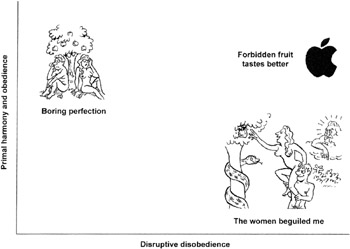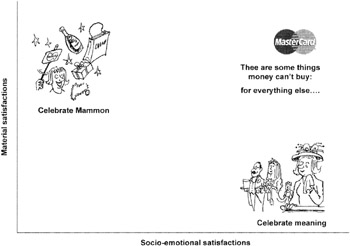THE CHALLENGE FOR BRANDS
Most successful brands pose a problem, dilemma, or anomaly and go on to claim that their product can resolve that dilemma. The more familiar the situation is and the more it engages cultural archetypes or mental programs, the quicker consumers will understand and bring their cultural ideas to bear on the issue. For example, young children and babies are popular symbols of innocence, trusting their caregivers to look after them. Any danger to a child evokes an immediate protective response from witnesses. There would be screams from the street, for instance, were a child to be seen hanging out of a high window anywhere in the world.
It is striking that many successful brands all refer to a tension between two values, and that they credibly claim that their product can reconcile these dilemmas effectively. Let's look at some examples.
When Apple introduced the rainbow apple with a bite out of it as a logo in 1977, it was a clear reference to Eve's apple, the fruit of the tree of knowledge of good and evil. On the one side it referred to the attractiveness of the enormous knowledge and possibilities that the user was given, and on the other it referred to the ability of the user to be able to serve a computer and deal with enormous complexity.
The reconciliation that Apple could offer was that it was possible to do both playfully. This is shown in Figure 5.2.

Figure 5.2: Apple- knowing is disobedience
For a long time MasterCard stood as a model for finding an assessment between the satisfaction of material with spiritual matters, and the social and emotional meanings giving sense to all of this. Their tag line was "There are some things money can't buy."

Figure 5.3: Credit cards and meaningful lives
Starbuck was the name Herman Melville gave to his first mate in Moby Dick; no one remembers that today as they sip their cappuccinos. Starbucks' coffee can be seen as a reconciliation between the familiar safety of port and adventure on the wild sea of exotic coffees.
The HSBC bank approaches THT's own field. Their humoristic "The World's Local Bank" ad campaign shows - in a particularly consistent manner - all kinds of differences between cultures. The consistent pattern is that one organization (the HSBC Bank, of course) can help you in a multiplicity of cultural misunderstandings.

Figure 5.4: Starbucks - safe and exciting exploration
In a prizewinning campaign, which we have already referred to briefly , Volvo has attempted to reconcile speed and security by showing a child in the back of a car accompanied with the copy:

Figure 5.5: HSBC - the unity of diversity

Figure 5.6: Volvo - dangerous road hogs and safe children
"Always take care of the future. Especially when the future is behind you."
Obviously positioning brands on mutually excluding orientations in a 2 x 2 matrix has proven its usefulness , at least as a starting point for analysis. For example, it is striking that the axes can not only be interpreted differently but also expressed differently across several cultures. In the UK, for instance, Stella Artois - a high-status brand - is considered a socially differentiated symbol, whereas in Belgium it is on every street corner, because you can always find a bar with Stella conspicuously displayed. Saab is seen as a mundane family car in Sweden, whereas in the US it is a sign of the fact that you have succeeded in life. Moreover some brands succeed in reconciling seemingly contrary values internationally. Renault has successfully created a quite specific image, applying the slogan of "Createur d'Automobiles" to a complete range of models. Volkswagen tries to unite youthful dynamics with reliability. Possibly a third dimension is necessary to explain their success, particularly in the way in which they try to reconcile contrary values.
EAN: 2147483647
Pages: 82